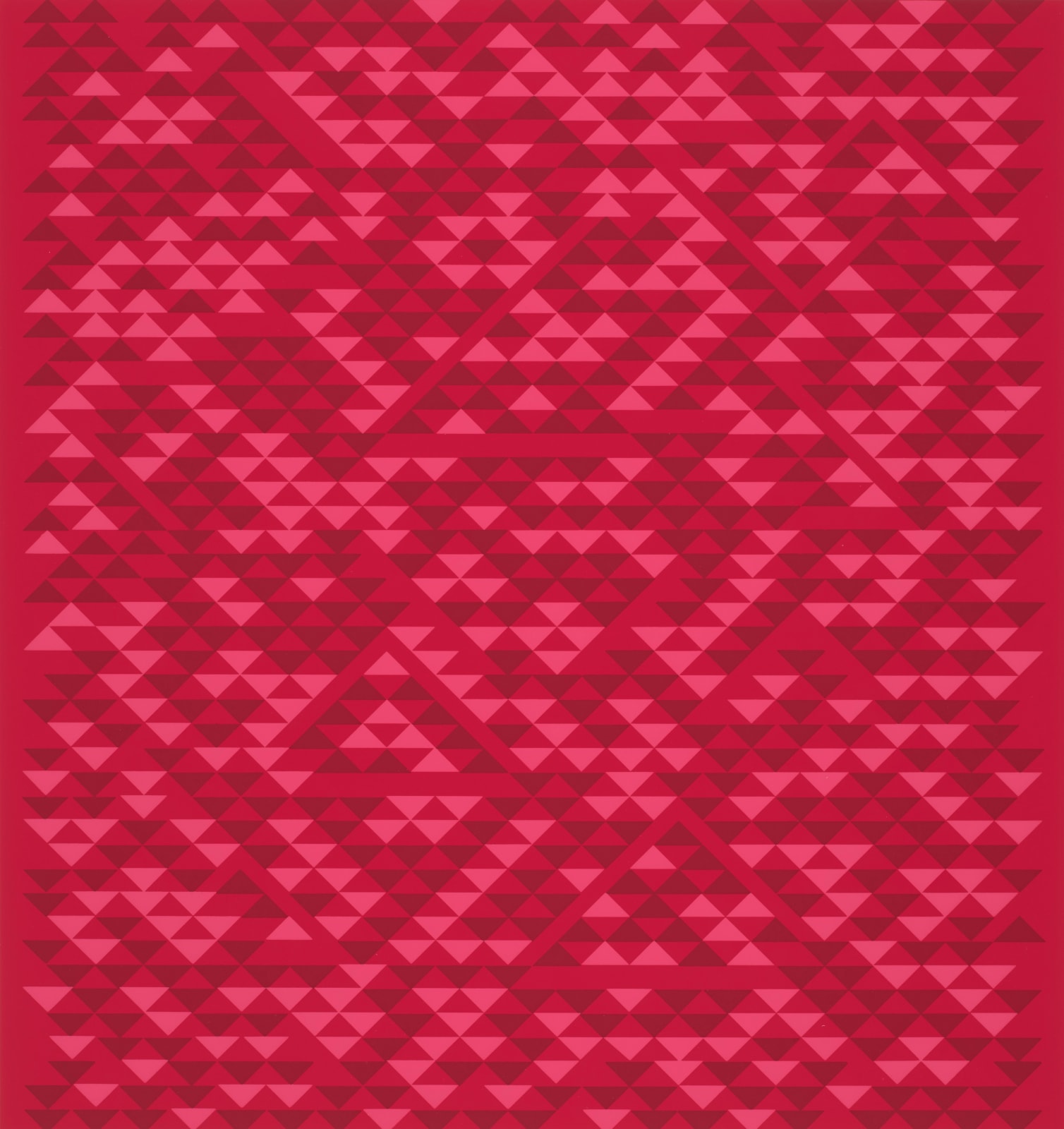Anni Albers
Further images
The arrangement of muted pink, crimson, and burgundy triangles in Anni Albers’ Camino Real is mesmerizingly reductive. The lighter triangles leap off the paper, while the dark ones recede into the mid-toned background, creating an illusion of depth that is surprising for such an ostensibly minimal composition. However, closer observation reveals that this screenprint is anything but simple. Prolonged viewing unveils a mastery of precision, balance, and craftsmanship, suggesting that there is far more to this piece – and to its artist – than meets the eye. This sense of mystery is highly intentional. Originally designed as a wall hanging for the Hotel Camino Real in Mexico City, this artwork celebrates the enigmatic nature of Mexico’s pre-Columbian history. Anni Albers, who first visited Mexico in 1935, was fascinated by the country’s artistic culture and unique creative force. A textile artist trained at the Bauhaus in the early 20th century Germany, Albers' values of economy of design, balance, and the absence of subjective gesture resonated strongly with the geometric traditions of pre-Hispanic Andean and Mesoamerican art and architecture.
The Hotel Camino Real, designed by Luis Barragán and Ricardo Legorreta, was originally built to house dignitaries attending the Olympic Games of 1968. As part of the hotel design, several contemporary artists were commissioned to create works for its public spaces, including Alexander Calder, Mathias Goeritz, Rufino Tamayo, and Anni Albers. Albers’ resulting piece was a monumental tapestry abstracting the pre-Columbian landscape and architecture that had captured her imagination. This seminal work, entitled Camino Real, revived a set of rug designs she had made in 1959 (Vicara Rug I and Vicara Rug II) and informed many of her later works, including the present screenprint conceived together with the tapestry between 1967 and 1969, which radically changed the entire course of her work as a printmaker.
Unlike many of Albers’ textile designs, the tapestry Camino Real is not woven but made in appliquéd felt on cotton backing. This technique allows for sharp, clean lines, an effect that she found great satisfaction in and that contributed to her increasing focus on screenprints, etchings, and lithographs. Her extensive background in textiles allowed her to concentrate on texture and color as well as functionality and architecture in ways that would not have been possible with other mediums. Camino Real and the related studies laid the foundation to push the second half of her career to new, groundbreaking levels. She described her transition from textiles to graphics as first learning to “listen to threads and to speak their language.” As evidenced by the tapestry Camino Real, Anni Albers mastered textiles, and “with the listening came gradually a longing for a freedom beyond their range.” The freedom she found in this and other screenprints is abundantly clear in her use of precise and clean lines, creating a powerful and unique universe that encompasses the entirety of her oeuvre.
NOTES
Image: 16 x 15 in (40.6 x 38.1 cm)
Sheet: 23 1/2 x 22 in (59.7 x 55.9 cm)
Signed, titled, dated and numbered in pencil from the edition of 90.
Other proofs of this important work are housed in the esteemed collections of the British Museum in London, UK, The Cleveland Museum of Art, Cleveland, OH, The Worcester Art Museum, Massachusetts, and the MACBA in Barcelona, Spain.
Provenance
The Josef and Anni Albers Foundation, Bethany, CTPrivate collection, United States
Private collection, New York
Exhibitions
London, The British Museum, G30, The American Dream, 9 Mar - 18 Jun 2017, cat. no. 95 (another example exhibited).
Paris, Fondation Custodia, The American Dream: Pop to the present, 2 Jun - 2 Sept 2018 (another example exhibited).
Madrid, La Caixa Forum, The American Dream: Pop to the present, 8 Oct - 31 Jan 2020-21 (another example exhibited).
Barcelona, La Caixa Forum, The American Dream: Pop to the present, 2 Mar-13 Jun, 2021 (another example exhibited).
Zaragoza, La CaixaForum, The American Dream: Pop to the present, 13 Jul-14 Nov 2021 (another example exhibited).
Literature
Brenda Danilowitz and Nicholas Fox Weber. The Prints of Anni Albers: A Catalogue Raisonne, 1963-1984. Bethany, CT: The Josef and Anni Albers Foundation, 2009, no. 12, pp. 46-47 (another example illustrated).Brenda Danilowitz (ed.). Anni Albers: Camino Real. New York: David Zwirner Books, 2020, pp. 22-23 (another example illustrated).






